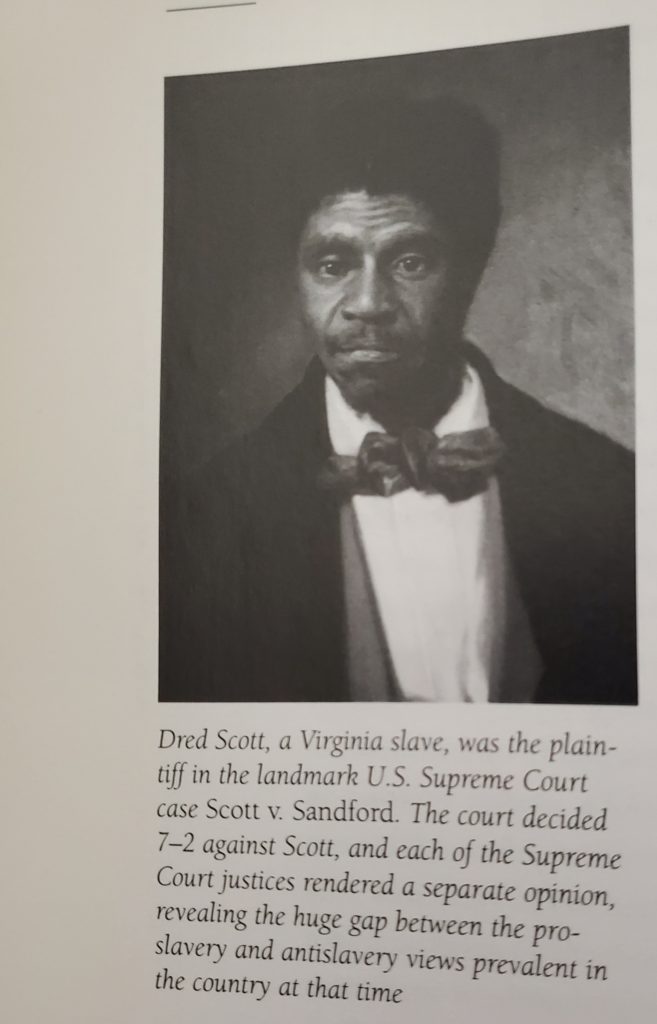The year was 1857 and James Buchanan was president of the United States. Three years prior, a case was brought before the Supreme Court. Slavery in the territories was a hot political issue.
When I was a child, I vaguely remember hearing about The Dred Scott case from my Dad and older brother. As much as they tried to explain, my young ears did not comprehend what they were telling me. As I aged, this case never left my memory.
Dred Scott was born into slavery around 1795 and was the “property” of a Virginia family who moved to St. Louis in 1827. Six years later, he was sold to an army surgeon, Dr. Emerson, and his wife. The following year, the Emerson’s were transferred to Illinois, where slavery was forbidden by state law. When they returned to Missouri in 1848, Mr. Scott had lived on free soil for five years and was entitled to his freedom.
Dr. Emerson died in 1846, his widow’s brother, an abolitionist, helped Mr. Scott sue for this freedom. Later in 1846, Dred and Harriett Scott filed suit in Missouri. The state’s highest court ruled that Missouri law determined Mr. Scott’s freedom. The court determined that he would remain a slave. In the interim, there was a battle between free-soil and proslavery faction in the border state of Kansas.
Mr. Scott’s case went all the way to the Supreme Court. The Chief Justice at the time was Roger B. Taney. He was thought to be a fair judge. Sixteen years earlier, the court freed the Amistad mutineers and he, being a resident of Maryland, had freed his own enslaved people years ago. When he was a young lawyer, he argued that slavery was a blot on our national character.
It was interesting to learn, as an attorney general for Andrew Jackson, he had written an opinion paper that black people were not citizens of the country. He was now eighty years old and was hearing the most famous slave case in the nation’s history. His decision would affect the future of slavery and the status of black people in America.
On March 6, 1857, a blow was given to black Americans. It was his opinion that black people were not intended to be included in the Constitution for the enjoyment of any personal rights of benefits. Mr. Scott was not a citizen of Missouri within the meaning of the Constitution and not entitled to sue in court.
The court had a Southern majority and issued a 7-2 ruling and made three rulings. First, he wrote this statement about black people. “Being of inferior order, who had no rights which white men were bound to respect,” Mr. Scott was not a citizen and had no rights to sue in federal court. The second ruling indicated the Missouri Compromise was unconstitutional because Congress had no right to ban slavery in a territory. Finally, the Court decided that the Scotts being taken in and out of free states did not affect his status. Neither slaves nor their descendants could ever be citizens. The effect of the ruling was to overturn the Missouri Compromise, prohibiting slave holders from taking enslaved people north of the compromise line. No law could deprive a citizen of “property” anywhere in the United States.
The message from the Supreme Court was clear. A person’s skin color determined his citizenship and ability to share in the democracy. The Founding Fathers had written a proslavery document and black people did not have rights. While the ruling did not enslave free black people, it encouraged free states to strip away their remaining rights as citizens.
There was intense reaction to the Dred Scott decision from black people. Abolitionist speaker, Charles Lenox Richmond met with an excited crowd in Philadelphia. He and other black people supported the formation of black military associations across the North to encourage military preparedness in black communities. They formed the Massasoit Guard without state sanction and paraded the streets of Boston, armed and in full uniform. Similar military operations were operational in other Northern cities. Their goal was to march through the South as well.
By 1860, slaveholders and their sympathizers controlled the Supreme Court and major committees of Congress, and had strong support from President Buchanan. Many Southerners feared its ability to protect slavery was in danger. They were afraid the abolition movement was growing and they called from secession from the United States.
Reportedly, Mr. Scott and his family were sold to another family and were freed on May 26, 1857. He died just over a year later.
Francie Mae, November 19, 2021.
References
Clayborne Carson, Emma J. Lapasansky-Werner, Gary B. Nash. 2007.The Struggle For Freedom, A History of African Americans. Pearson Longman.
Johnson, Charles and Smith, Patricia. 1998. Africans in America. America’s Journey through Slavery. A Harvest Book. Harcourt Brace and Company. San Diego. New York. London.
James Oliver Horton and Lois E. Horton. 2005. Slavery And The Making of America. Oxford University Press, Inc. New York.
